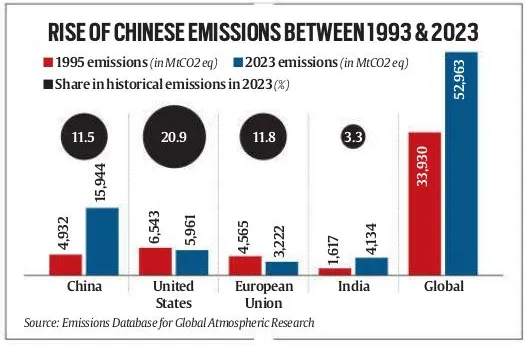Table of Contents
China’s Domination and Current Status

- Global Emissions Leader: China contributes over 30% of global annual emissions.
- It remains the world’s largest emitter for over 15 years.
- Its emissions are now 3 times that of the United States.
- Renewable Energy Manufacturing Hub: China controls:
- >80% of global solar panel manufacturing, dominating every step of production.
- ~60% of global wind turbine production.
- Large shares in batteries, hydrogen electrolysers, and critical minerals required for clean energy.
- Economic Leverage: Solar panel manufacturing costs in China are 10% lower than India, 20% lower than the US, and 35% lower than Europe.
- Renewable Energy Deployment: Added 300 GW of renewable energy capacity in 2023, expected to reach 1,200 GW by 2024, 6 years ahead of schedule.
The Need for Chinese Emission Cuts
- Analysis by Climate Action Tracker (CAT): It indicates that China needs to reduce its emissions by 66% by 2030 and 78% by 2035 to align with the 1.5-degree Celsius target set by the Paris Agreement.
- However, such deep cuts are deemed unrealistic in the near term due to China’s ongoing economic recovery and energy-intensive growth patterns.
- NDC Ratings: China’s Nationally Determined Contributions (NDCs) are rated as “highly insufficient,” indicating that current policies do not align with the goals necessary to limit global warming.
Challenges and Paradoxes
- Dependence on Fossil Fuels: Renewable energy is expanding capacity but not replacing fossil fuels.
- g., renewables only make up a single-digit percentage of its primary energy supply, and coal generates over 50% of its electricity.
- Impact of Emission Cuts on Global Supply Chains: The production of renewable energy equipment like solar panels and wind turbines heavily relies on fossil fuels.
- If China makes deep emission cuts:
- It could slow the deployment of renewable energy equipment globally, impacting energy transitions worldwide.
- This would jeopardise the goal to triple renewable energy capacity by 2030.
- Differentiated Responsibilities Under Climate Agreements: As a “developing” country under the UN climate framework, China is not mandated to make immediate, deep emission cuts. This limits global pressure.
- If China makes deep emission cuts:
Way Forward
- Diversification of Global Supply Chains: Other countries should invest in renewable manufacturing to reduce over-dependence on China.
- Gradual Transition from Fossil Fuels: Implement phased coal reduction plans while scaling up renewable integration to ensure a stable energy supply.
- International Collaboration on Technology: Facilitate partnerships for cost-competitive production of renewable equipment outside China, especially in regions like India, Europe, and the US.
- Balanced Emission Reduction Plans: Encourage China to adopt incremental emissions reduction targets without jeopardising global renewable production.
- Innovation in Low-Carbon Manufacturing: Invest in research to reduce the carbon footprint of renewable energy equipment manufacturing.
- Policy Incentives for Green Energy: Global frameworks must incentivize China to accelerate clean energy transitions through financial and technological support.


 UNESCO Global Network of Learning Cities...
UNESCO Global Network of Learning Cities...
 National Livestock Mission (NLM): Object...
National Livestock Mission (NLM): Object...

























